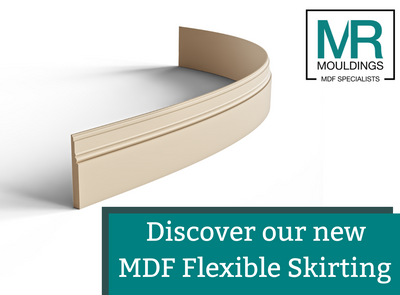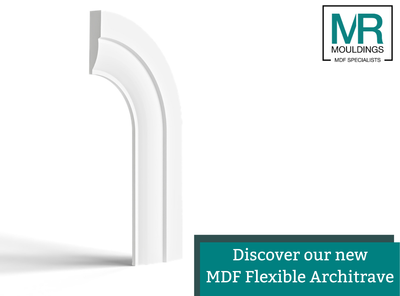
The History of Skirting Boards: From Architectural Roots to Modern-Day Style
Skirting boards might seem like a small part of a room, but they carry a rich history and serve a purpose that goes far beyond decoration. These modest mouldings have evolved through centuries of architectural innovation, adapting to changing tastes, building methods, and lifestyles.
So, what is the history of skirting boards, and how did they become such an essential part of British interior design?
Skirting boards date back to classical architecture, where base mouldings protected walls and defined proportions. In Georgian and Victorian homes, they became taller and more decorative. Today, modern MDF skirting boards continue the tradition, offering protection, style, and structure in every room while reflecting centuries of architectural evolution and design trends.
In this post, we’ll take a deep dive into their origins, development through key design periods, and their role today, while showing how MR Mouldings’ MDF skirting boards offer a modern take on a timeless interior tradition.
Where It All Began: The Classical Foundations of Skirting Boards
To understand the story of skirting boards, we have to go back to classical architecture. In Ancient Greece and Rome, interiors were framed with heavy stone mouldings, plinth blocks and baseboards that protected walls from damage in busy public buildings and elite homes.
These early base mouldings served both functional and aesthetic purposes:
-
They concealed uneven transitions between floor and wall
-
They added structural strength to delicate plaster finishes
-
They provided visual grounding, anchoring columns and walls in proportion
Fast forward to 18th-century Britain, and these ideas began influencing domestic architecture.
Skirting Boards in the Georgian Era (1714–1830)
The Georgian period was known for symmetry, balance, and proportion, driven by architects like Robert Adam and the principles of Palladian design. Walls in stately homes were often lined with wood panelling, and skirting boards became part of the overall scheme, rather than a standalone trim.
Key Features:
-
Tall skirting boards (200mm–400mm) in richly carved hardwoods
-
Installed as part of full-height timber panelling or wainscoting
-
Often stained, oiled or finished to highlight the wood grain
-
Used to hide rough plasterwork, uneven flooring, and thermal bridging
In wealthier homes, skirting was part of a broader trim package, paired with ornate cornices, dado rails, and picture rails to frame rooms in a consistent style.
The Victorian and Edwardian Periods: Ornament, Mass Production & Middle-Class Homes
As the Industrial Revolution transformed Britain, joinery techniques became more advanced and accessible. This marked the rise of the Torus, Ogee, and Chamfered skirting profiles, made in pine or fir and shaped using early machines.
Skirting boards were no longer exclusive to stately homes. They became a standard feature in the growing number of middle-class terraces and villas built during the 19th century.
Key Developments:
-
Machine-tooled profiles allowed consistent shapes at scale
-
Softwood became more common due to its affordability
-
Skirting was often stained or varnished rather than painted
-
Used to block draughts from timber floors and fireplaces
-
Often paired with high skirting heights to match ceiling proportions
Victorian skirting boards were practical, but they were also a visual expression of pride and prosperity. More elaborate rooms had deeper profiles, while servant quarters had thinner, more functional skirting.
Early 20th Century: From Decorative to Domestic Utility
In the Edwardian era (1901–1914), interior styles softened slightly, embracing more light and space. Skirting profiles became slightly lower (typically 150–180mm) and more refined, with cleaner chamfered edges and softer curves.
By the mid-20th century, especially after the Second World War, functionality took centre stage. Materials were limited, labour was expensive, and the British home became simpler and more efficient.
The Shift:
-
Skirting boards were now primarily painted white
-
Styles became standardised and less decorative
-
Typical heights reduced to 100mm–125mm
-
Used for pure function: to hide flooring gaps and protect from knocks
This era also saw the introduction of softwood skirting as the norm, but it came with challenges; knots, warping, and cracking often required repairs and repainting.
Late 20th Century: The Rise of MDF
Everything changed in the 1980s and 1990s with the growing popularity of Medium-Density Fibreboard (MDF).
MDF revolutionised skirting board manufacturing:
-
It offered a smooth, knot-free surface perfect for painting
-
It didn’t warp, split or twist like timber
-
It could be shaped into a wide variety of profiles
-
It was more affordable and easier to work with on-site
Moisture-Resistant MDF
As home insulation improved and moisture levels in homes fluctuated due to central heating and indoor plumbing, moisture-resistant MDF (MR MDF) became the ideal solution. It could be used:
-
In kitchens and bathrooms
-
Around underfloor heating
-
In modern construction with tight tolerances
At MR Mouldings, we manufacture all skirting boards using high-quality MR MDF, combining durability, ease of installation, and a professional finish that stands the test of time.
Want the benefits of tradition and innovation? Browse Our MDF Skirting Board Range
Skirting Boards in Today’s Interiors: Style & Substance
Today, skirting boards serve the same three purposes they always have:
-
Covering expansion gaps between floor and wall
-
Protecting plasterwork and paint from impact
-
Adding visual definition and architectural grounding
But now, they also offer more design flexibility than ever. Homeowners, designers, and developers are using skirting boards as an intentional part of room styling, not just a finishing piece.
Current Trends:
-
Tall skirting boards (150mm–230mm) in modern homes for luxury effect
-
Minimalist square edge profiles in contemporary apartments
-
Heritage skirting boards in period property renovations
-
Coloured skirting (e.g., black, navy, olive) to create contrast with pale walls
-
Integrated trim sets matching skirting, architrave, and wall mouldings
From painted MDF to flexible skirting that curves around bay windows or staircases, there are options to suit every home, and at MR Mouldings, we supply profiles to match.
Looking for design inspiration? See our guide: Which Skirting Board Style Should I Choose?
Why Skirting Boards Have Never Disappeared
Despite changes in architecture and design, skirting boards have remained a constant for over 300 years. Why?
Because they do three things better than anything else:
-
Protect walls from daily wear and tear
-
Complete the look of a room, linking walls, floors, and furniture
-
Conceal flaws, gaps, and uneven transitions
As homes have evolved, from panelled mansions to energy-efficient flats, so too have skirting boards. And with the rise of high-performance MDF, they’re now more durable, customisable, and cost-effective than ever.
MR Mouldings: A Modern Take on a Historic Classic
We honour the history of skirting boards by designing profiles that balance traditional craftsmanship with modern performance.
Our MDF skirting boards are:
-
✅ Made from moisture-resistant MDF, engineered for longevity
-
✅ Pre-primed for faster decorating and cleaner finishes
-
✅ Available in a wide selection of classic and contemporary profiles
-
✅ Manufactured in the UK with consistent precision and care
-
✅ Used by developers, trades, and homeowners across the country
Whether you're restoring a Georgian terrace, renovating a 1930s semi, or furnishing a modern flat, we provide skirting boards that respect tradition while delivering performance you can rely on.
Final Thoughts: A Timeless Detail with a Modern Edge
From the ornate carved panelling of Georgian homes to the sleek shadow-gap designs of today’s interiors, skirting boards have evolved alongside architecture itself.
They began as practical trim and became a mark of craftsmanship, style, and detail. And today, thanks to advances in materials like moisture-resistant MDF, they continue to play a vital role in both protection and design.
By choosing high-quality skirting boards from MR Mouldings, you’re not just finishing your room; you’re taking part in a centuries-old design tradition, reimagined for modern living.
Explore Our Collection of MDF Skirting Boards
Looking to bring timeless design to your space?
👉 Browse Our Skirting Board Range
High-performance MDF. Pre-primed. Built for homes that care about detail.



